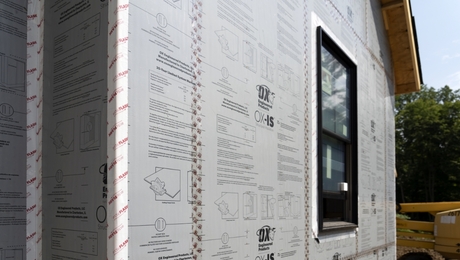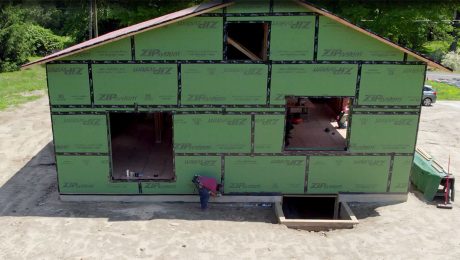Why You Should Pay Attention to Manufacturer Instructions
When it comes to installation methods for generic building products, the code often defers authority to the manufacturer for guidance.

Synopsis: Consultant Glenn Mathewson explores how to interpret what the code says when pointing you to other resources and the importance of having instruction manuals for your building products on-site, especially during inspections.
Modern residential building codes are filled with references to generic, commodity building products—things like dimensional lumber, wood structural panels, and concrete. The ways you can incorporate these generics in a house doesn’t change based on who made them; the code either prescribes how to use them in various assemblies or refers you to other resources, such as the Wood Frame Construction Manual, for guidance. A lot of what goes into houses, though, isn’t generic.
Along with generics, building codes also recognize a range of proprietary products. This recognition is meant to provide design freedom by establishing a path to use any product or material you desire. However, codes don’t give us prescriptions for how to use these products; instead they establish the performance the products have to meet and then defer authority to manufacturers, which have to establish that their products meet or exceed the code’s expected performance when installed using a particular method—the backbone of installation instructions. There are a few ways in which the code props up manufacturers’ installation instructions as the law of the land for the products they make: It directs you to follow them; it tells you to have them available during building inspections; and it leans on them as a path to approving alternative materials that are not specifically mentioned in the code.
Follow the instructions
Clauses that mandate following manufacturer’s installation instructions can be found on over 200 of the 1100 pages of the 2021 International Residential Code (IRC), often occurring multiple times per page. These references recognize that the performance the code expects can only be achieved when products and materials are installed correctly, and that the manufacturer is the authority to explain how to do that.
How the IRC directs us to those instructions is not always straightforward. It’s important to keep in mind that the IRC is a mash-up created over centuries from different professionals, organizations, and committees. The development of building codes occurs in different events at different times than plumbing and mechanical codes. The fuel-gas codes in chapter 24 are heavily influenced by the American Gas Association; the electrical chapters are developed by the NFPA; and the Chapter 11 energy-conservation provisions are now developed through a completely different process than the other I-codes. As a result, the IRC ends up with a lot of inconsistencies in terminology that can lead to confusion in interpretation.
Those 200-plus pages of the IRC with references to following the manufacturer “instructions” include the following alternative phrases: “written instructions”; “printed instructions”; “installation instructions”; “approved instructions”; “recommendations”; “minimum recommendations”; “installation recommendations”; “requirements”; “installation requirements”; “specifications”; “product specifications”; and “installation specifications.”
I want to say the code is perfect, and the specific words matter. They do, until they don’t. I will say that the words alone are not the intent and purpose of the code, they simply attempt to reveal it. Understanding that the IRC is Frankenstein’s monster combined from various codes, it’s safe to say the 13 different phrases for a manufacturer’s “installation instructions” are not intended as 13 different meanings. It’s not uncommon to hear people argue that the reference to “recommendations” is not mandatory in the way a reference to “requirements” is, but I’m here to tell you, the IRC references to the instructions—including those that don’t include the word “instructions”—are mandatory, regardless.
Chapter 2 of the IRC provides definitions for terms and phrases used in the code that have an application and meaning that differs from standard English definitions. In the 2009 edition, the International Code Council attempted to format I-Codes to italicize terms in the body of the code when the term applies to the chapter 2 definition. When not italicized, the standard definition would apply. It’s no secret to those in the code industry that this formatting has’t been maintained consistently in subsequent code updates, and italics are no longer a valid method of interpreting whether a term applies the code’s definition or not. See what’s defined in chapter 2:
“[RB] MANUFACTURER’S INSTALLATION INSTRUCTIONS. Printed instructions included with equipment as part of the conditions of their listing and labeling.”
This definition is maintained by the Building Code committee of the IRC, designated by the “[RB]” preceding the term. Notice that “equipment” is not italicized. However, equipment is also defined:
“[MP] EQUIPMENT. Piping, ducts, vents, control devices and other components of systems other than appliances that are permanently installed and integrated to provide control of environmental conditions for buildings. This definition shall also include other systems specifically regulated in this code.”
This definition is from the mechanical and plumbing committee (“[MP]”), so it specifically applies to systems that “control environmental conditions.” However, the final sentence refers to “other systems.” This is a rabbit hole we could go down for pages to try and nail down what the IRC really expects these terms mean, but the truth is that it hasn’t been thought out very well. The point is simply to do what the manufacturer tells you based on the testing that proves the performance of the product, whether it’s HVAC equipment or asphalt shingles.
Available during inspection
The IRC refers to “written” and “printed” manufacturer instructions in some instances and not others, but I need to stress that this is not intentional. Chapter 1 of the IRC provides administrative provisions to support the application and administration of the code and to describe the duties of the people involved. Here’s what it says about instructions:
“R106.1.2 Manufacturer’s installation instructions. Manufacturer’s installation instructions, as required by this code, shall be available on the job site at the time of inspection.”
One of the most common inspection failures related to manufacturer installation instructions is simply not having them available during the inspection. While a printed copy would be the foolproof choice, I wouldn’t turn away a tablet computer with digital instructions handed to me during inspection. However, this section is only addressing those moments during inspection. The IRC is clear and serious about its partnership with manufacturers in sharing authority— so much so that when there’s a conflict between a code provision and a manufacturer’s requirement, it defers to the manufacturer:
“R102.4 Referenced codes and standards. The codes and standards referenced in this code shall be considered part of the requirements of this code to the prescribed extent of each such reference and as further regulated in Sections R102.4.1 and R102.4.2.
“Exception: Where enforcement of a code provision would violate the conditions of the listing of the equipment or appliance, the conditions of the listing and manufacturer’s instructions shall apply.”
For approval of alternatives
Another situation where manufacturer installation instructions become an extension of the code is in the approval of alternative products. Many modern materials and products used in construction are not specifically recognized or validated in the code. But the IRC is ultimately after performance. Section R104.11 provides guidance for building officials to approve products not specifically included in the IRC by validating their stated performance through documentation. Manufacturers test their products in specific installations under standardized conditions particular to the application and acquire third-party evaluation reports stating the performance achieved when installed in a particular fashion. The installation instructions must replicate the installation used in the testing. Under these situations, the installation instructions again become a required part of the approval and are thus required for inspection:
“R104.9 Approved materials and equipment. Materials, equipment, and devices approved by the building official shall be constructed and installed in accordance with such approval.”
Though I encourage otherwise, most residential contractors do not have a copy of the locally adopted code on the job site. Understanding that the manufacturers’ instructions take precedence, I encourage you to keep all of them on the job site. Depending on your project or trade specialization, make a three-ring binder with installation instructions of all the common products you use. You will reinforce your confidence in properly installing the products to code, and you will reinforce the inspectors’ trust in your professionalism when you furnish the information upon request.
Glenn Mathewson is a consultant and educator with BuildingCodeCollege.com.
From Fine Homebuilding #311
RELATED STORIES






























View Comments
Thank you, Glenn, for relaying your experience and advice in such a clear way! I have been practicing architecture for over 20 years, but just started focusing on residential work in the past 5 or so. The beginning of this year has been incredibly eye-opening when it comes to guarding my value and limiting my liability during the construction phase. I am taking several pointers from your article to implement in my processes and deliverables.